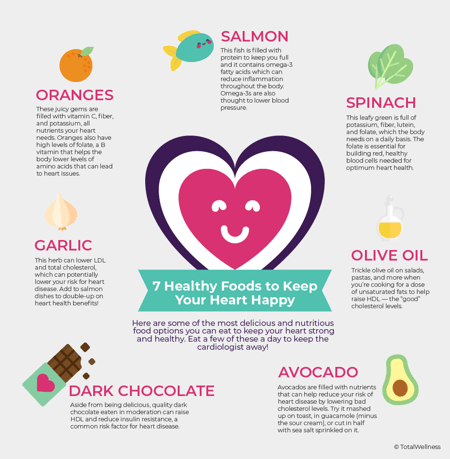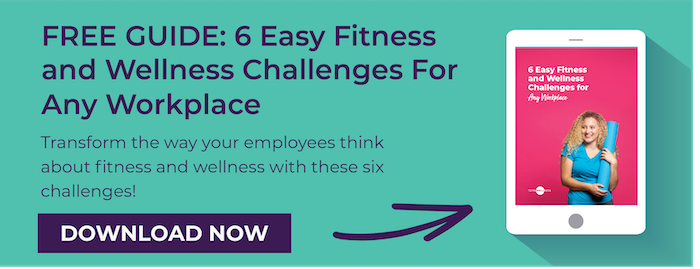 Every year, World Heart Day is celebrated on September 29.
Every year, World Heart Day is celebrated on September 29.
Since Cardiovascular Disease (CVD) claims 17.9 million lives globally each year, the World Heart Federation created the campaign to educate and encourage individuals to improve their heart health.
Over a lifetime, the heart beats about 2.5 billion times. That’s a hard-working muscle. Like every other muscle in our bodies, it’s important to keep it strong and healthy.
If you’ve been looking for ways to discuss heart health with your employees, now is the time.
In honor of World Heart Day, share these 29 tips on how to keep your heart healthy:
29 Ways to Keep Your Heart Healthy
Interested in learning more about heart health? Here are 29 proven ways to keep your ticker healthy on World Heart Day and every day!
- Kick Butts
Stop smoking. It’s the number one way to immediately improve your heart health. Talk to your doctor if you need help kicking the habit. - Know Your Healthy Weight
Talk to your doctor about your Body Mass Index (BMI), which is your percentage of body fat. Ask about the ideal caloric intake for your height and weight. Excess weight can put excess strain on your heart. - Maintain Your Healthy Weight
Even a loss as small as 3% to 5% body weight can help lower blood pressure if you’re overweight. Staying active daily — even just a brisk walk — can help keep the pounds off. - Limit Salt
The Heart Foundation recommends less than 2,000 mg of sodium daily. Too much salt can lead to high blood pressure, which can cause a stroke, heart attack, and more. - Eat Your Fruits and Vegetables
Eating more fruits and veggies can never hurt you — unless it’s fried, of course. The American Heart Association recommends making half of your diet intake fruits and vegetables. See our infographic for the best foods for heart health! - Eat More Chicken (and Fish)
Chicken and fish often have less saturated fat than red meat, which is better for your heart. Eating fish with omega-3 fatty acids (like salmon) can reduce cardiovascular disease risk. - Limit Red Meat to Once a Week or Less
Red meats have more cholesterol than other meats like chicken or fish. Since cholesterol can make your heart disease worse, try to limit it and choose lean cuts like sirloin. - Eat More Soluble Fiber
Soluble fiber lowers cholesterol and helps manage blood sugar. Consider eating foods like whole grains, berries, flaxseed, and beans to avoid the “crash” of eating less fibrous foods. - Increase Omega-3 Fatty Acids in Your Diet
You can choose either foods or prescribed supplements to get omega-3 fatty acids in your diet. It may help reduce blood pressure, lower triglyceride levels, and protect the heart by slowing plaque growth and reduce arrhythmia. - Add Oatmeal to Your Diet
Oatmeal is fiber rich and contains omega-3 fatty acids, folate, and potassium. Eating oatmeal may also help lower levels of LDL (bad) cholesterol. - Follow Your Health Plan and Take Your Medications
Work with your doctor to create a plan that works for you and stick with it. This includes taking any and all prescribed medications for health conditions like high blood pressure. - Exercise Regularly
A minimum of 40 minutes for 3 to 4 times a week is ideal for the best cardiovascular health results. Check out our post on 7 Exercise Tips for Beginners! - Do Different Types of Exercises
Keep your body guessing. Mix up your fitness routines with cardio, strength training, and stretching. All are important for good health. - Limit Alcohol
Women should have no more than 1 drink per day. Men should consume no more than two alcoholic beverages per day. Too much alcohol can raise triglyceride levels. - Limit Sugar
The recommendation is no more than 6 teaspoons a day for women and 9 teaspoons a day for men. Read labels to see where sugar is hiding, including breads and condiments. Excess sugar intake is linked to certain cancers, heart disease, and obesity. - Switch to Olive Oil
Olive oil is full of monounsaturated fats, lowers LDL (bad) cholesterol. It may help reduce risks of developing heart disease. - Monitor Your Cholesterol
Have your cholesterol checked at least every five years. You’ll want to do this more if your doctor has discovered any issues like high cholesterol in the past. - Watch Your Blood Pressure
High blood pressure can cause heart disease, kidney disease, and it has been linked to dementia. Check yours regularly. - Manage Diabetes
Work with your doctor to manage blood sugar levels to protect your heart health. - Mitigate Stress
Stress can raise blood pressure and lead to elevated levels of the hormones adrenaline and cortisol in the body. Find ways to relieve stress — like deep breathing— that work for your lifestyle. - Eat Some Soy
Soy is low in saturated fat and can potentially lower cholesterol. Research shows consuming 25 grams of soy protein daily can lower LDL by up to 6%. - Practice Good Oral Health
Good dental hygiene includes brushing and flossing your teeth daily. Those who have gum disease often have risk factors for heart disease. - Donate Blood
At least every six months, consider donating blood. Studies have shown that people who donate regularly suffer fewer heart attacks. - Be Social
Studies show that people who stay in regular contact with family and friends have fewer heart problems. - Catch Enough ZZZs
Adults typically need 7 to 9 hours of sleep a night. Sleep deprivation is not only bad for your heart and blood pressure, but it also raises risks for obesity, diabetes, and depression. - Read and Understand Food Labels
Just because a food product is labeled as low-fat or healthy doesn’t mean it is. "Partially hydrogenated" or "hydrogenated" means trans fats, which aren’t good for the heart. Monitor sugar and salt amounts per serving and know how many servings are in the package. - Choose Natural Over Processed
In general, the less processed a food is, the healthier it is. Think of “whole foods” as foods that are naturally grown like sweet potatoes, bananas, and spinach. - Choose Baked Over Fried
Think baked buffalo wings, baked fries, and crunchy baked chicken instead of automatically tossing those food items into a fryer. - Minimize the Risks of a Sedentary Lifestyle
Sitting for too long can lead to blood clots. You’ll want to be mindful of the length of time you sit every day and also when you travel. Try to get up and stretch to avoid a blood clot forming.
Heart Health Stats to Share With Your Employees
Aside from the 29 helpful tips above, you may want to consider sharing these tidbits below about CVD with your employees for World Heart Day.
Cardiovascular Disease (CVD) Statistics
- An estimated 17.3 million people worldwide die of CVD every year
- Approximately 1 in every 4 deaths in the U.S. is caused by heart disease
- Heart disease is the leading cause of death for men and women
- Someone has a heart attack every 40 seconds in the U.S.
Encourage Employees to Keep Up With Heart Health
The heart is an amazing part of the human body that works without us even thinking about it — until a heart issue pops up.
Remind employees throughout this month leading up to World Heart Day the importance of eating heart healthy foods and how to keep the heart healthy.
A lunch and learn event is the perfect way to get employees excited about heart health. If you have a wellness committee, ask them to bring in a dietician or nutritionist to discuss how to incorporate heart health foods into diets. A cardiologist may offer interesting insight on the importance of monitoring heart health and exercising regularly.
Poor genes aren’t the only reason people have heart concerns. Take this time to remind employees that much of their heart health is in their control from eating habits to exercising; they can make healthier heart choices.
Ready to encourage employees to work on their heart fitness? Consider downloading our FREE step-by-step 6 Easy Fitness and Wellness Challenges for Any Workplace guide!



